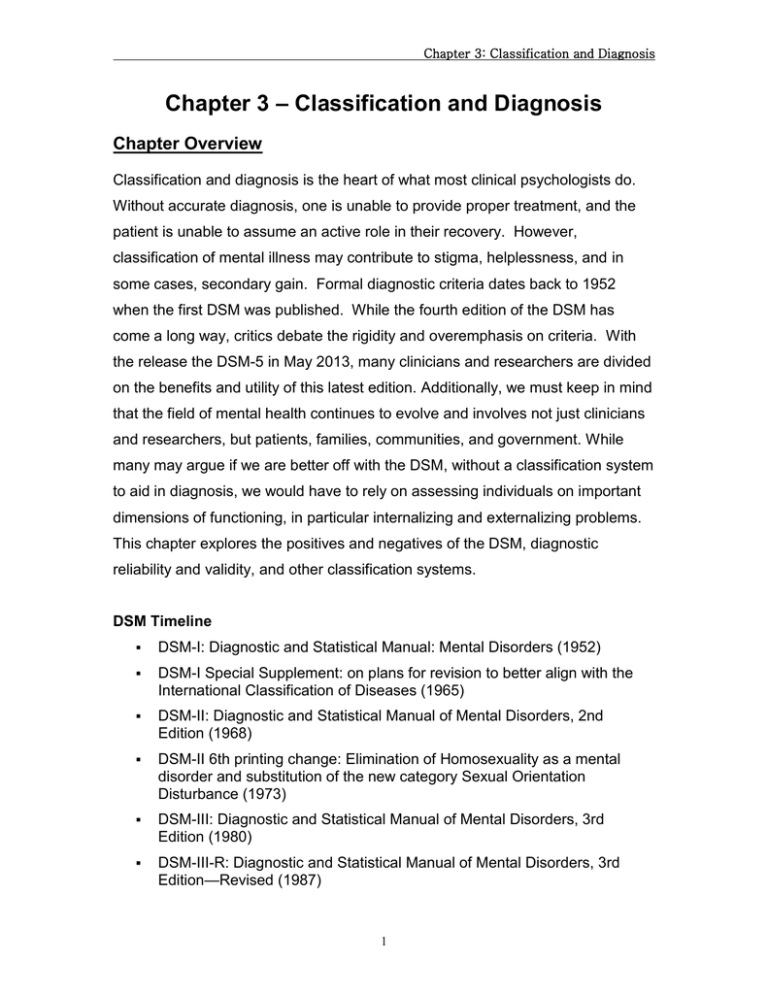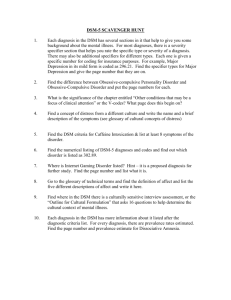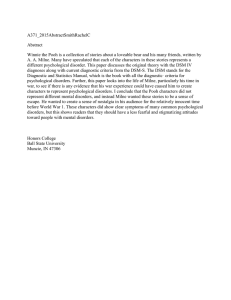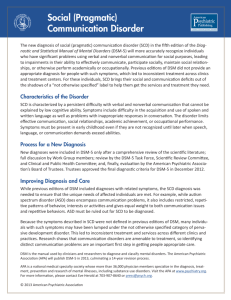– Classification and Diagnosis Chapter 3 Chapter Overview
advertisement

Chapter 3: Classification and Diagnosis Chapter 3 – Classification and Diagnosis Chapter Overview Classification and diagnosis is the heart of what most clinical psychologists do. Without accurate diagnosis, one is unable to provide proper treatment, and the patient is unable to assume an active role in their recovery. However, classification of mental illness may contribute to stigma, helplessness, and in some cases, secondary gain. Formal diagnostic criteria dates back to 1952 when the first DSM was published. While the fourth edition of the DSM has come a long way, critics debate the rigidity and overemphasis on criteria. With the release the DSM-5 in May 2013, many clinicians and researchers are divided on the benefits and utility of this latest edition. Additionally, we must keep in mind that the field of mental health continues to evolve and involves not just clinicians and researchers, but patients, families, communities, and government. While many may argue if we are better off with the DSM, without a classification system to aid in diagnosis, we would have to rely on assessing individuals on important dimensions of functioning, in particular internalizing and externalizing problems. This chapter explores the positives and negatives of the DSM, diagnostic reliability and validity, and other classification systems. DSM Timeline DSM-I: Diagnostic and Statistical Manual: Mental Disorders (1952) DSM-I Special Supplement: on plans for revision to better align with the International Classification of Diseases (1965) DSM-II: Diagnostic and Statistical Manual of Mental Disorders, 2nd Edition (1968) DSM-II 6th printing change: Elimination of Homosexuality as a mental disorder and substitution of the new category Sexual Orientation Disturbance (1973) DSM-III: Diagnostic and Statistical Manual of Mental Disorders, 3rd Edition (1980) DSM-III-R: Diagnostic and Statistical Manual of Mental Disorders, 3rd Edition—Revised (1987) 1 Chapter 3: Classification and Diagnosis DSM-IV: Diagnostic and Statistical Manual of Mental Disorders, 4th Edition (1994) DSM-IV-TR: Diagnostic and Statistical Manual of Mental Disorders, 4th Edition, Text Revision (2000) DSM-5: Diagnostic and Statistical Manual of Mental Disorders, 5th Edition (2013) Chapter Contents Introduction Defining Abnormal Behavior and Mental Disorders Developmental Psychopathology Diagnosis Defining Disorder Prevalence of Mental Disorders Understanding the Development of Mental Disorders The Diagnostic and Statistical Manual of Mental Disorders (DSM) System The Evolution of the DSM The DSM-5 The International Statistical Classification of Diseases and Related Health Problems (ICD) System Limitations of Diagnostic Systems Heterogeneity of Symptom Profiles Summary and Conclusions Learning Objectives 1. What is the difference between a categorical versus a dimensional approach? 2. What are the uses of a diagnostic system? 3. How do we define abnormal behavior? 4. Why is developmental psychopathology important? 5. Discuss what is meant by diagnosis. Why is it based on a cluster of 2 Chapter 3: Classification and Diagnosis symptoms? 6. How do we define disorder? How does culture play a part in the definition? 7. What is the prevalence of mental disorders? 8. How do mental disorders develop? 9. Discuss the effects of PTSD on the patient and on loved ones. 10. What is the DSM approach to diagnosis? 11. How has the DSM evolved? 12. What are the differences between the DSM-IV-TR and the DSM-5? 13. What are the benefits and limitations of the DSM-5? 14. Discuss the use of the ICD system? 15. Why is diagnostic reliability important for assessment? 16. Why is diagnostic validity important for assessment? 17. How does comorbidity impact diagnosis and prognosis? 18. Are dimensions a better way to describe and understand mental disorders? Up for Discussion 1. What makes a person’s behavior abnormal? 2. Does society set the standard for abnormality? Why? 3. Is it better to have a formal diagnosis or would you prefer not to know? 4. Is ADHD overdiagnosed? 5. Does a diagnosis of ADHD limit or help a child? 6. Referring to Table 3.1 on the Prevalence of Selected Mental Disorders, what explanations can you give for the high rates of anxiety, mood, impulse-control, and substance abuse in the various countries? 7. Why would immigrating to another country exacerbate mental illness? 8. How is the biopsychosocial model a more thorough model as compared to the medical or biological model? 9. Should the DSM include actual diagnostic categories for such disorders as childhood depression and bipolar disorder? Why or why not? 3 Chapter 3: Classification and Diagnosis 10. Role play with one of your students and have one of your students conduct a mock interview of you presenting as either a depressed or anxious patient. Have the student take notes and write up a brief psych assessment. Share with the class and discuss the interview skills, the questions, and the brief psych assessment. 11. Break students up into groups of 4-6 persons per group to form “assessment teams” and have them review 1-2 cases per group. The cases are included in the appendix of this Instructor’s Manual, or you may have them review your own cases. Go over the cases with each group after the 30 minutes of review. Discuss the findings and rationale for diagnosis. 12. Are the limitations of the DSM-5 problematic? Why or why not? 13. How does resilience play a critical role in one’s prognosis for recovery? 14. Discuss the issue of social desirability and how this may impact diagnosis? Out-of-Class Activities 1. Encourage students to visit a mall, park, or another public place and observe the people around them. They should note what they see, the verbal and non-verbal interactions, and the thoughts and reactions that may occur to them. Have students discuss how their own feelings and reactions could affect diagnosis. 2. Ask students to write up their own ideas to replace or enhance the DSM. Ask them to provide rationales and justifications for the omission or additions. 3. Divide students into two teams. Team 1 would research the pros of the DSM, and team 2 would research the cons of the DSM. The following week have the team debate the issues of the DSM with the instructor serving as the moderator. 4. Have students watch a movie or television program and write up an assessment of the main characters. Students should provide clinical terminology, demonstrate a clear understanding of the limitations of their assessment, and formulate questions they would ask the character in a real interview. 4 Chapter 3: Classification and Diagnosis 5. Have students practice their interviewing skills on a friend or family member, noting both their reactions and the reactions of the “patient”. Ask students to discuss why treating a family member or friend is not advised. Discuss the boundaries and limitations as well as social desirability of the friend or family member. Also, discuss the impact this would have on therapy. Web Links Information on the DSM-5, including its history and use, can be found at this American Psychiatric Association site: http://www.psychiatry.org/practice/dsm Information on the development of the DSM-5 can be found on this American Psychiatric Association site: http://www.dsm5.org/about/Pages/DSMVOverview.aspx For information on the World Health Organization’s International Classification of Diseases, go to: http://www.who.int/classifications/icd/en/ The National Institute of Mental Health provides a wealth of data on the prevalence of mental disorders: http://www.nimh.nih.gov/index.shtml This is the home page of the American Psychiatric Association, the publishers of the DSM-5. You will find links to the various sections, journals, and online resources about education, practice, and self-help resources. Most psychiatrists belong to this organization. http://www.psych.org/ Video Suggestions Primal Fear (DVD, color, 130 min.) A high-powered attorney takes the case of an alter boy found running away from the scene of the murder of a Catholic bishop who had taken him in. This is a courtroom thriller with twists and turns and a surprise ending. The highlight is the diagnostic challenges throughout the movie. 1996 Paramount Copycat (DVD, color, 123 min.) An excellent thriller about a copycat murderer and a reclusive criminal psychologist battling PTSD and panic disorder with agoraphobia. 1995 Warner Brothers First Break (Video, color, 51 min) First break is the first episode of mental illness 5 Chapter 3: Classification and Diagnosis in a person's life. Three young adults and their families discuss the challenge of living with a diagnosis of mental illness, and its impact on their self-identities and family relationships. 1997, Fanlight Productions, Boston, MA. Disorders Due to Psychoactive Substance Abuse (Video, color, 34 min) Psychiatric diagnosis can be classified into several main categories. This program focuses on alcoholism and the five main areas involving psychoactive substance abuse: dependence syndrome, withdrawal state, withdrawal state with delirium, psychotic disorder, and amnestic syndrome. Interviews with several alcoholics illustrate the various mental disorders associated with the illness, their symptoms, and the differential diagnoses associated with each, including Korsakov's psychosis. 1998, Films for the Humanities and Sciences, Princeton, NJ. What Is Normal? (30 min., Insight Media). Explores the question of what distinguishes normal from abnormal and the classification of abnormal behavior using the DSM. Madness: To Define True Madness (60 min., PBS Video). Examines attitudes toward mental illness throughout the history of Western culture. Suggested Readings Barnett, J. E., & Johnson, W. B. (2008). Ethics desk reference for psychologists. Washington, DC: American Psychological Association. American Psychiatric Association. (2000). Diagnostic and statistical manual of mental disorders (4th ed., text revision). Washington, DC: Author. First, M. B., & Tasman, A. (Eds.). (2004). DSM-IV mental disorders: Diagnosis, etiology, & treatment. Hoboken, NJ: John Wiley & Sons. Journal of Abnormal Psychology Journal of Abnormal Child Psychology Archives of General Psychiatry American Journal of Psychiatry Childhood Mental Health Disorders. 2008. Brown, R.T., Antonuccio, D.O., DuPaul, G.J., et al. American Psychological Association. On the Stigma of Mental Illness – Practical Strategies for Research and Social Change. 2005. Corrigan, P. W. American Psychological Association. Thesaurus of Psychological Index Terms: 30th Anniversary 10th Edition. 2005. American Psychological Association. Assessment and Treatment of Childhood Problems: 2nd Edition: A Clinician’s Guide 2002. Schroeder, C. S. & Gordon, B. N. The Guilford Press. 6 Chapter 3: Classification and Diagnosis Assessment in Behavioral Medicine. 2001. Vingerhoets, A. Brunner/Routledge. Classification and Diagnosis of Psychological Abnormality. 2002. Cave, S. Routledge Publishers. Rethinking the DSM: A Psychological Perspective. Beutler, L.E. & Malik, M.L. 2002. American Psychological Association A Pocket Reference for Psychiatrists: Third Edition. Jankins, S.C., Tinsley, J.A., & Van Loon, J.A., 2001, American Psychiatric Press. How to Identify Suicidal People: A Systematic Approach to Risk Assessment, White, 1999, Charles Press Publishers 7



